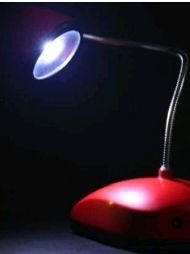![]() While most agree that LEDs will someday replace compact fluorescents as the energy-efficient lights of choice for homes and businesses, that day often seems far off. LEDs, which emit light from a semiconductor chip instead of interaction with a gas, have always been bulky and expensive, and the illumination they give off isn’t exactly mood lighting. But recently, it has begun to look like lighting companies may overcome those problems more quickly than anticipated.
While most agree that LEDs will someday replace compact fluorescents as the energy-efficient lights of choice for homes and businesses, that day often seems far off. LEDs, which emit light from a semiconductor chip instead of interaction with a gas, have always been bulky and expensive, and the illumination they give off isn’t exactly mood lighting. But recently, it has begun to look like lighting companies may overcome those problems more quickly than anticipated.
Intematix got its start tackling the light quality problem. Unlike the soft light that incandescents are valued for, LEDs light tended to be harsh, generally coming in bright reds, blues or an off-kilter white. The company specialized, until recently, in making a phosphor coating for the semiconductor in LEDs that could produce a more attractive light, for which it drew funding from top VCs like Crosslink Capital and Draper Fisher Jurvetson, as well as tech giant Samsung.
But while Intematix was honing its chemistry, other companies made headway into the remaining problems. It now looks like LEDs will replace CFLs as the lighting technology of the future, and Intematix has joined the ranks of companies aggressively pushing to install the lights in houses and businesses.
With a new $5.2 million strategic investment from a manufacturing partner in Asia, Intematix has taken over a plant in Taiwan and vertically integrated to produce entire “light engines” — a term that CEO Peter Larsson uses because an LED is more complex than the bulbs you’re used to. A complete LED bulb requires components for cooling the back of the unit, optics to diffuse the light, and a power supply.
 Notably, Intematix provides the tiny 1-watt bulbs that D.light Design uses in its cheap, solar-powered lamps for families in developing countries. It is also designing a tube-shaped LED that will replace the big fluorescent lights in parking garages.
Notably, Intematix provides the tiny 1-watt bulbs that D.light Design uses in its cheap, solar-powered lamps for families in developing countries. It is also designing a tube-shaped LED that will replace the big fluorescent lights in parking garages.
Aside from LEDs, Intematix has also started using its phosphors for CFLs, which, like LEDs, don’t producing desirable light without some tinkering. And the company is finding serious potential in a third business, the cold cathode fluorescent (CCFL) tubes that are used in LCD televisions.
Those two areas could turn out to be a big business, but Larsson is confident LEDs have serious potential. “The market is only going to expand as LED prices come down,” he told me, noting that the semiconductors used in LEDs have improved rapidly over the past year, putting out more light per watt. Despite pouring money into ongoing research, he expects Intematix to become profitable by the end of this year.
A number of other companies have also taken investments this year to tackle LEDs, including $5.25 million for Illumitex, $6 million for Optoelectronix and a whopping $72 million for Luminus Devices.

